Hey Everyone!! I have missed you... I have been FLAT out this week! Literally...!! Ill explain later...
But for today... I am so excited to Introduce Cara to you!! She is a super Mum! She has put an amazing Tute together for us... The Circle of Geese Block.. I have absolutely NO IDEA how to make this block so i jumped up and down when she said she would share this with us..... Thanks Cara... xx
Today I'm going to show you how to successfully sew a Circle of Geese block without hurling your scissors across the room or pulling out your hair. This is one of those blocks that can intimidate many but trust me when I say if I can do it, you can do it.
This is a paper-pieced block which means you stitch your fabric onto a piece of paper following the lines that are pre-printed on the paper. And it really is that easy once you get the knack of it. This block is a lot like learning how to ride a bike. It might be hard at first but, once you learn it, you wonder how you ever struggled.
The trickiest part of assembling this block, in my opinion, is that it involves lots of turning and flipping and folding back of fabric and paper pieces. It's easy to get confused and make mistakes so this tutorial has a ton of pictures.
This tutorial also involves some extra steps to help you avoid issues. As you get more comfortable with how to assemble the block, you can cut out some of the extra steps. Or you can throw caution to the wind and just skip them all together from the get go.
Okay, so let's get started.
First you need the template. I like to use this one. (Note: sometimes that link doesn't work for whatever reason. If that's the case for you, go to http://www.piecebynumber.com/and go to the freebie tab. Look under geometric and you'll see the circle of geese block.) When you print it out, make sure it's printing full scale and not being scaled down. I had to decrease my margins to get it to properly fit on one page. You'll need four copies for each block. Print out a few extras to have on hand.
Next, cut it out ALONG the dotted line. This will be the finished size of your block section and you'll use the edge of the paper as your trim line when you are finished, so cut it out neatly and accurately.
As you'll see, the sections of this template are numbered. Throughout this tutorial, I'll be referencing these pieces by their number (#1, #2, #3, etc).
Because you will eventually be tearing the paper off from the fabric, I highly recommend perforating the lines on the paper before you begin sewing. To do this, simply stitch along all the inside lines without thread in your needle. IMPORTANT: set your stitch length to the smallest setting so that your stitches -- or in this case, the holes -- are close together.
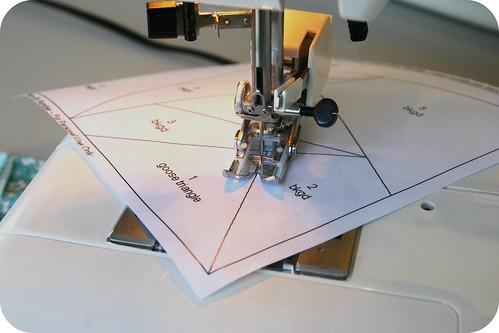
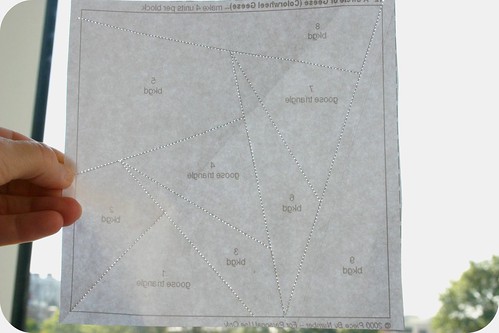 The other nice thing about perforating the lines in advance is that it's handy for when you need to fold back the paper along the lines. And in this tutorial, you'll be doing that a lot.
The other nice thing about perforating the lines in advance is that it's handy for when you need to fold back the paper along the lines. And in this tutorial, you'll be doing that a lot.Okay, next step.
Cut out fabric for your background pieces and fabric for your goose triangle pieces. I find 3" x 5" is a good size; you can go smaller as you get more comfortable but I like to give myself room for error. The first few times you assemble this block, it's helpful to start with larger cuts of fabric. Most of my early mistakes involved using a piece that I swore was big enough but after sewing and turning it, it would be too short. Trust me when I say you'd rather have some fabric waste than the frustration of having to unpick a section because it ended up being a few millimeters short.
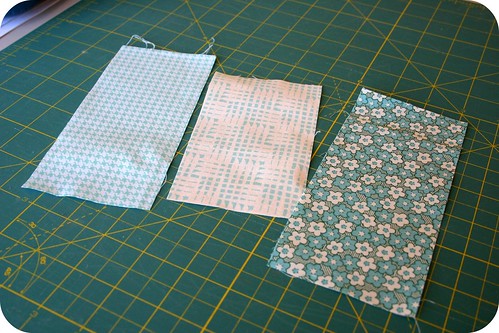 |
| For my goose triangles. |
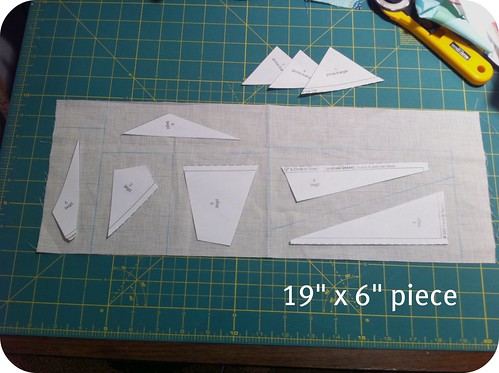 |
| If fabric waste is a concern, a 19" x 6" piece will fit all six background pieces. |
Take the fabric piece for your first goose triangle and lay it with the wrong side facing up (right side facing down). Place your template on top of the fabric with the words facing up.
Fold the paper template together at the line between #1 and #2 and -- using the edge created by the fold as a guide, trim the fabric to leave what will be a 1/2" seam allowance. (As you get better at this block and need less room for error, you can trim it to 1/4" instead.)
Now you are ready to position the fabric for #2. I know, I know, when are we going to start stitching, right? Hang with me. Place the background fabric (#2) right side facing up under the #1 fabric. Line them up as noted on the photo below and pin.
Let's stitch! Fold your paper flat again and stitch along the line between #1 and #2.
After you are finished stitching, fold the paper back again at the line between #1 and #2 and use the edge of the paper to trim the fabric to 1/4 inch seam allowance. Like I said, you can skip this step obviously if you initially trimmed to 1/4 inch seam allowance in the previous step.
Now turn the paper over and press your fabrics open.
Okay, now from here on out on this tutorial, my photos are going to show the pieces labeled so that you don't get confused. You don't have to do this at home, though I do find it helpful to write the numbers on the back of the paper.
Okay, now you're ready to move onto #3, a background piece. Place your sewn pieces right side down and fold your paper along the line between #3 and #1-#2. Go ahead and trim (leaving either 1/4" or 1/2").
Now you're ready to place and sew piece #3.
You can either slip piece #3 under the #1, #2 pieces or flip the block over and place piece #3 on top of pieces #1 and #2 (like in the picture below). Which ever way you pick, just be sure your fabrics are right sides together.
Stitch along the line between #3 and #1-#2. Turn paper over and press fabrics open.
Next you'll turn your paper over so the fabric is right side down. Fold back the paper along the line between #3 and #4. Continue to repeat the same previous steps of trimming, lining up the next fabric piece, pinning, folding the paper flat, stitching, and ironing the fabric open.
Are you getting the hang of it? Go ahead and finish up #5, #6, #7, #8 and #9 following the same steps as above. Just remember to go in sequential order.
Almost done! Time to trim. Use the paper as your guide and trim to the paper. If you are trimming paper off, you are trimming too much. (Sorry, I forgot to get a shot of what the block looks like on the back before trimming.)
When you are ready, carefully remove the paper. I find that it helps to start with removing #9 and working backwards (#8, #7, #6, etc.).
Once you have four sections completed, you are ready to arrange them and sew them together.Sew A to B and set aside. Sew C to D and set aside. Then sew AB to CD and you're done!
Ta-da! Aren't you fancy!!
Hopefully, I've been able to demystified the Circle of Geese block for you and you're not cursing my name right now. Happy sewing!! Feel free to come over to my blog and say hello!
Thanks sooooooooooooooooooo Much Cara!!! xx Mystery solved!! xx I hope you enjoyed her Tute... I did! xx









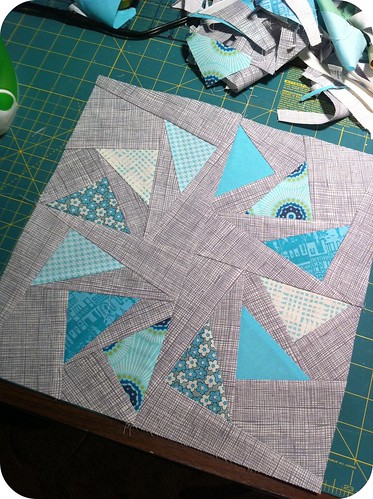
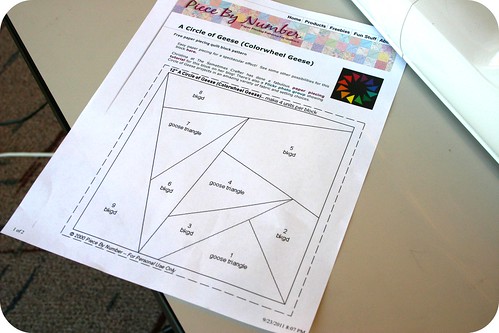


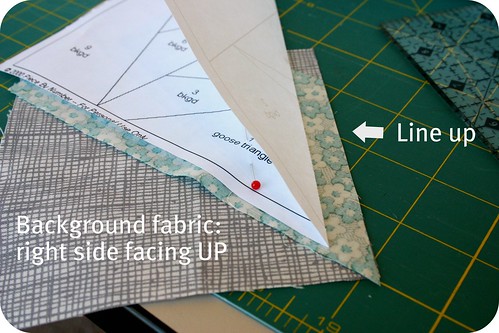
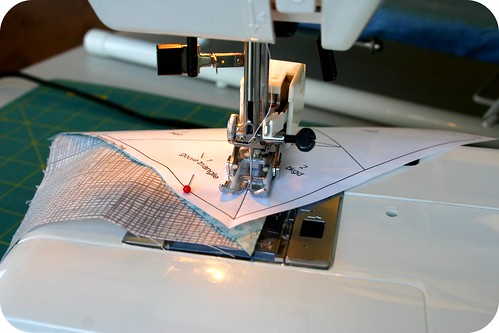

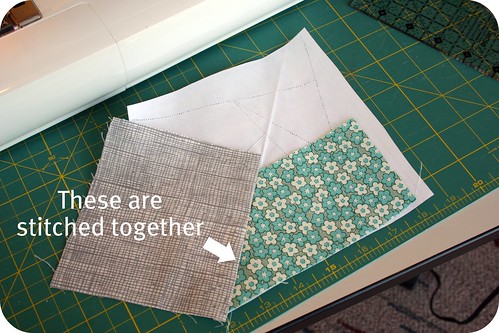
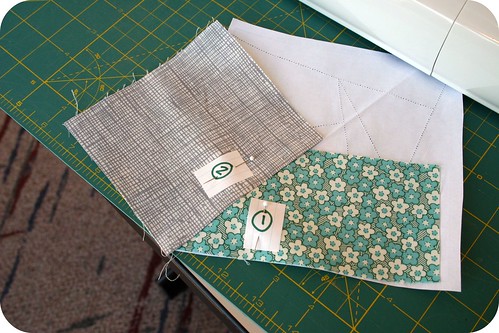
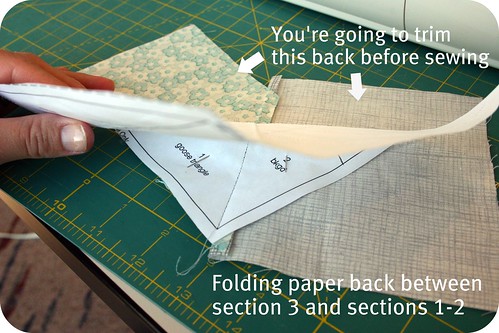
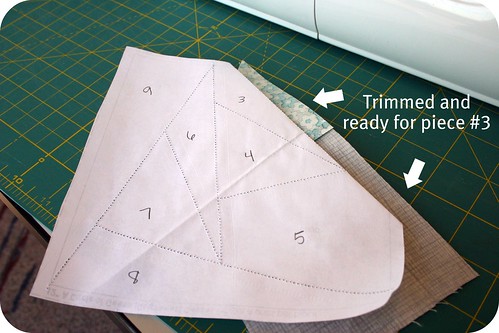

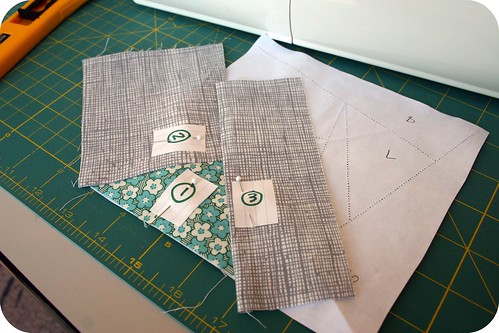
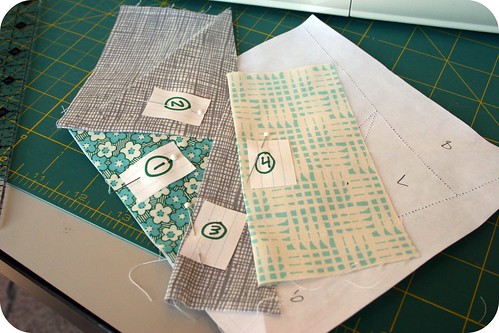
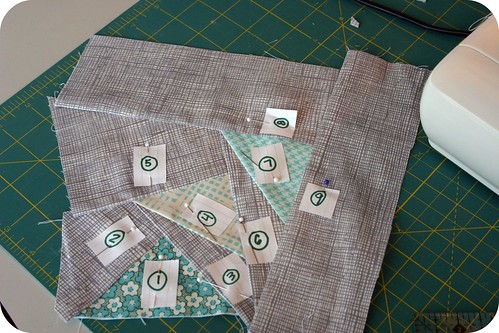
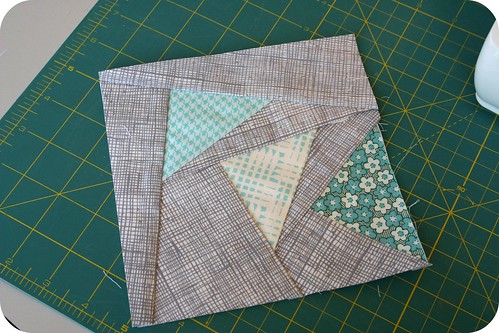
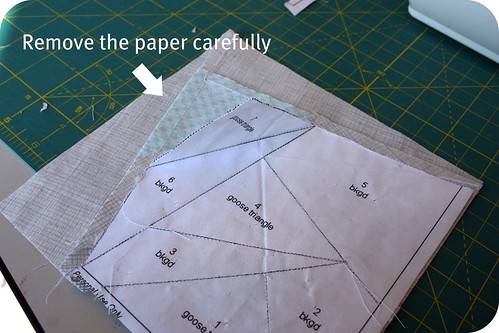
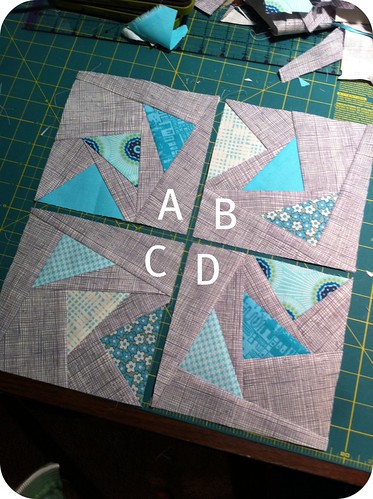
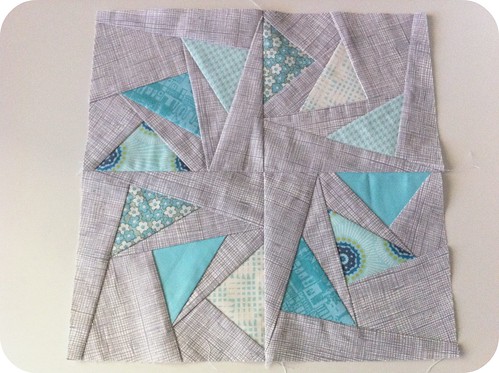
Love this block! You did a great job. I learned to paper piece a few months back when I did a Quilt-A-Long. This block has been on my things to try list! Great job on yours!
ReplyDeleteFantastic tutorial!
ReplyDeleteThanks for sharing!
Great sorrow that I must go to Tabajara like myself ... and sewing!
Seams good day!
Bec & Cara - Thank you!! Out of all of the paper piecing tutorials I've seen, this one makes the most sense to me!! Now - - I'll just HAVE to try it!! Thank you so much for this post!! You girls are the best!!
ReplyDeleteHugs ~~ Suz
inspiringcreativeness.blogspot
Wonderful tut. Makes me want to try paper piecing.
ReplyDeleteThank you Rebecca and Cara! I love that block and now it's sure I shall make it with your great tutorial! I haven't made even any paper piecing so this was a good lesson!
ReplyDeleteThanks so much Cara for a wonderful tutorial!!! I can't wait to try it out!! I've never done paper piecing before.
ReplyDeleteOh wow, thank you! I'll have to give this a try at some point and time!
ReplyDeleteThank you for the Circle of Geese tutorial. I really enjoy paper piecing. I use my add a quarter ruler to trim the seams...I find it helpful.
ReplyDeleteGreat tutorial, I have always admired this block and now I have to have a go!
ReplyDeleteI have always wanted to make this block. I've done paper piecing before but never heard anyone suggest pre-perforating the lines before. Good tip.
ReplyDeleteHI: I did this block, loved it and had a ton of fun doing it. Only problem I had was I used regular paper for my pattern. Bad idea. Too heavy to pull out stitching. But other than that the project was fun and turned out great. I made a pirate pillow to go with my grandson's pirate quilt. Great tutorial.
ReplyDeletecathy
So you are always sewing on the printed side of the paper along the printed lines? not on the back where you showed the lines that you sewed right? I really love this block and think it would look fantastic done up in all different colors with a white background. I've saved the pattern, but have never paper pieced, so didn't go there and try it because I had NO clue. Now I want to save your tutorial and give it a try.
ReplyDeleteCathy - if you perforate the paper beforehand, you should be able to use regular printer paper and remove it with ease.
ReplyDeleteMommarock - Correct. Always sew on the printed side of the paper along the lines. Have fun!!
I love paper piecing and the accuracy it creates - so I'm going to have to give this a go! Thanks!
ReplyDeleteSome tips to help the beginners, from a long-time PP'er...
ReplyDeletePrint one extra template & cut it up to use as a guide for selecting & trimming your fabrics. You can keep stripes (or directional fabrics) in line this way, as they are very difficult for beginners to use in triangles, if you want the stripes to come out a particular direction when done. Draw direction arrows ("UP") on each piece the pattern & lay them out on your fabric that way before cutting.
Using the extra paper pattern, pre-cut your pieces out roughly to size & shape, adding 1/2" on EVERY side. This really helps for odd-shaped pieces & avoids the "oops, I didn't cut a piece big enough" moment than can happen later.
After sewing two pieces of fabric together in the block, bend the paper & fabric back & trim the seam allowances to 1/4". Do this after every line sewn. You can also pre-trim the next seam to 1/4" (on the fabric already sewn down), which helps you know where to add the next piece of fabric. This also helps avoid coming out too short on the next piece.
I often keep the paper on the back while assembling the subunits of the block. I like having guide lines. Tweezers can get the paper out of the seams later. For tight spaces or odd angles, I only remove one section of the paper.
When done, if your paper is still on, you can baste around the edges (1/8" in) to keep everything in place. Use a dark colored thread so you know later which line is the basting. I often do this if the blocks will be stored away or handled a lot before being joined -- prevents fraying.
Carol Doak's papers are some of the best on the market when it comes to holding up through sewing -- and they're soft enough to remove very easily later (even without perforating first). Quilt shops carry them.
If you rip a pattern, don't use Scotch tape to fix it. Scotch tape & irons don't mix. A tiny bit of blue painter's tape is better. Also, I use blue painter's tape instead of pins when sewing my fabrics down. Very good to tape the opposite sides down from where you're sewing. Pins + fabric + paper can = distortion. Tape is better, faster, easier, etc.
If you use a laser jet printer, be careful that your iron doesn't transfer toner from iron sole to fabric when you're pressing on the front of the block. Keep a white paper towel on the ironing board edge & occasionally run the iron over it to remove any excess toner. Once it's on the fabric, it's very hard to remove. And it always seems to find its way to white fabric!
Hope those tips help. Happy paper piecing. It's addictive!
Thanks for the tutorial! Found you via "Me? A Mom?" blog. :)
It still looks a little intimidating even though I already do some paper piecing. I will have to sit and figure it out.
ReplyDeleteOh I just love this block. I am however not a huge fan of paper piecing, I find it quite wasteful, BUT I might have to try it anyways because it looks so amazing when finished.
ReplyDeleteThanks for the clear tutorial.
This looks sooo cool. Can't wait to try it. Thanks so much for the tutorial!!!
ReplyDeletethanx for the great tute! have it in my patterns now to make!
ReplyDeleteHa, I was just talking to a friend earlier about how we both wanted to learn how to do these, thank you so much!
ReplyDeleteI've been wanting to try this block for a while now...perfect excuse! Thanks so much!!
ReplyDeleteThanks for such and easy to follow tutorial! I've been wanting to try this block for a while, and now I feel prepared!
ReplyDeleteThanks for the fantastic tutorial. Makes it look like even I could do it successfully!
ReplyDeleteWow, love the block...the grey and blue are striking.
ReplyDeleteLooks beautiful, I really want to try this block!
ReplyDeletethank you for the awesome tutorial and also thank you for the long timer PPcer tips.
ReplyDeleteLove this block - really great clear tutorial. I was recently given a great idea for paper piecing. Rather than sewing onto the paper, trace the pattern onto very light interfacing and sew onto this. You don't need to remove the backing as it is thin enough the you don't even notice it on the back of the block when constructing the quilt.
ReplyDeleteThis looks wonderful and I definitely want to have a go now.
ReplyDeletelove this! thanx for sharing. feel better soon.
ReplyDeleteJust happened upon your blog and really liked this tutorial--amazing block! I've also enjoyed your quilts and fabric choices--super!
ReplyDeletebest from Tunisia,
nadia
Great block and tutorial + I love Jacquie's tip above. But I especially love the choice of fabrics/color palette. I keep coming back to look at it. So pretty!
ReplyDeleteI loved this tutorial. I have done paper piecing before and love how it looks when done. I have pretty much cursed my way through it. Thank you for showing me a much better way. I think I'll try again.
ReplyDeleteThank you! I must try this! Better than that $30 class I was about to sign up for.
ReplyDeleteWow, love the block, Circle of geese. There is something very charming about the ol' flying geese and this block is magic. Thanks for the tutorial. (btw love paper piecing).
ReplyDeleteVery very nice tutorial! I just finished machine quilting this block (made into a big quilt) for a customer of mine....to see it go to: http://chezstitches.blogspot.com/2012/07/few-days-ago-i-posted-here-some-ideas.html
ReplyDeletethere would be so many fun ways to quilt this block! really changes the look.
~karen
Thankyou so much...I love this block! Can't wait to put a colorful fall quilt together with it.
ReplyDeleteJust found this tutorial using my Circle of Geese block - super job! Hats off to you for showing how easy paper piecing really is. As you said, you struggle with it a little at first, but afterwards wonder why you had any troubles.
ReplyDeleteBTW, Here's the direct link to the pattern PDF if anyone is having troubles: http://piecebynumber.com/CircleOfGeese-PieceByNumber.pdf (It's on my to-do list to change web hosts...)
Happy sewing!
Beth
Piece By Number
piecebynumber.com
This comment has been removed by a blog administrator.
ReplyDeleteThese are fundamentally brief term loans that do produce you meet
ReplyDeleteyour fiscal problems inside a preferred distinct time
period. Thinking of time limitations these loans are specifically made above
an obligation cost-free platform. As such, these
are kept absolutely cost-free from credential checksums.
Troubles such as defaults, arrears, bankruptcy, CCJs
and even IVAs are not regarded as right here. Further,
there are also no collaterals linked with these loans.
There is minimal paper operate required on the aspect of borrower.
There are also no hidden or extra documentation or faxing expected right here.
Applying for these loans is also really convenient.
Consumers only call for filling an on the net form and
as soon as this gets approved cash is received inside 24 hours time frame.
These loans are frequently provided below practical terms and situations.
The general standard applicant criteria here is that they
should certainly be a UK resident and of 18 years of age.
my web page - go to